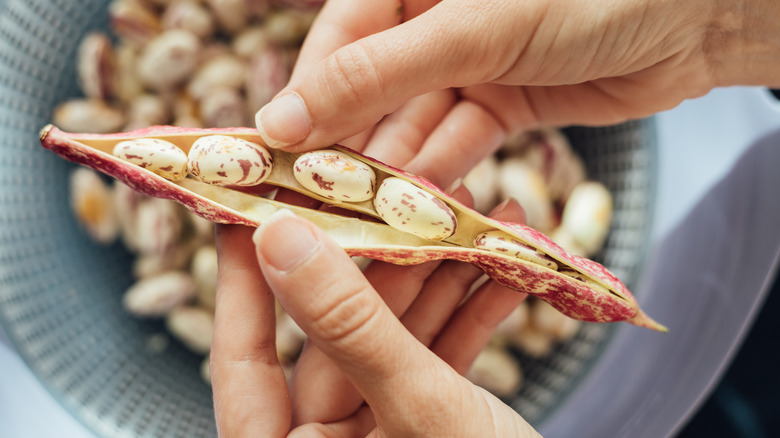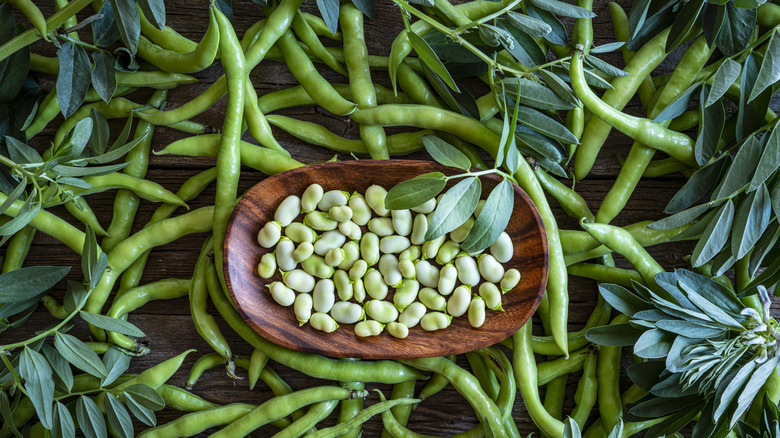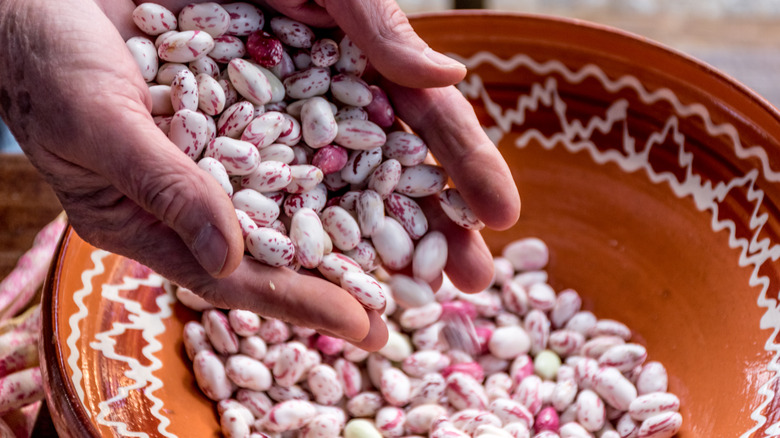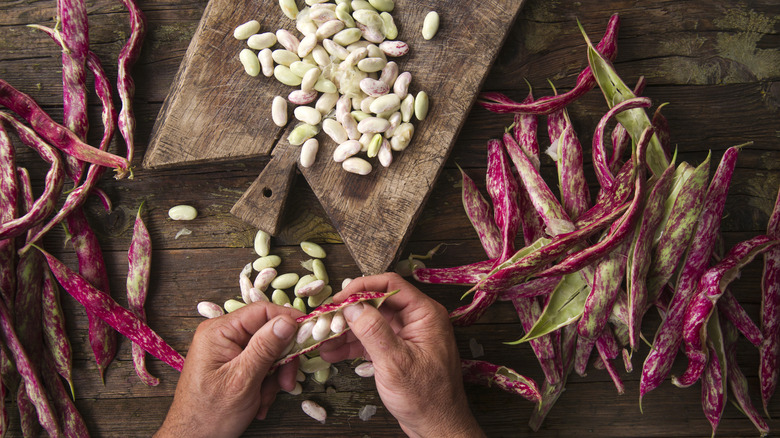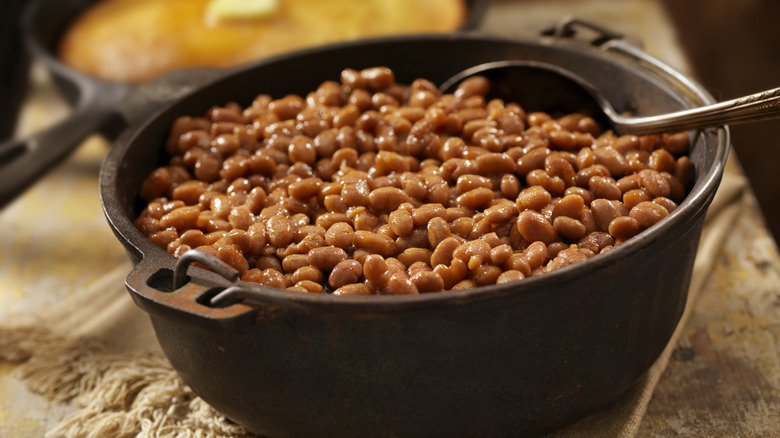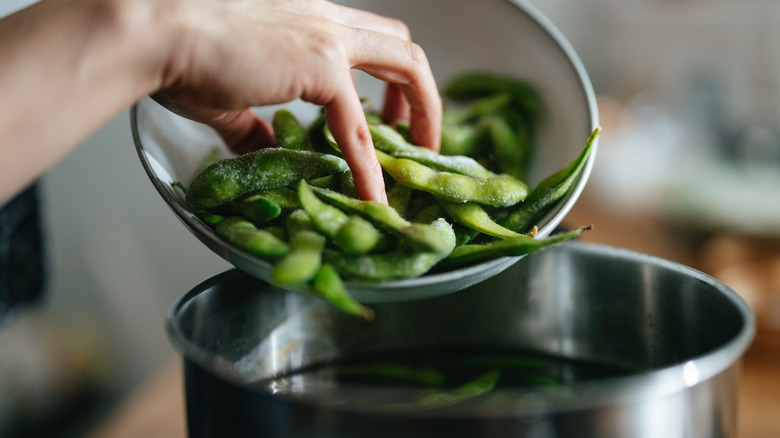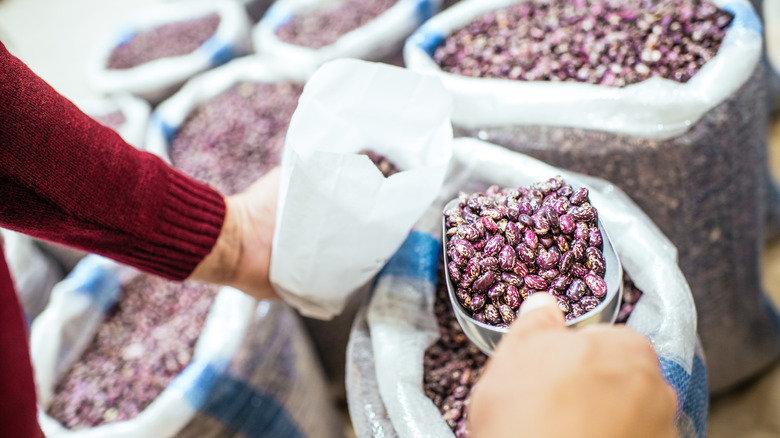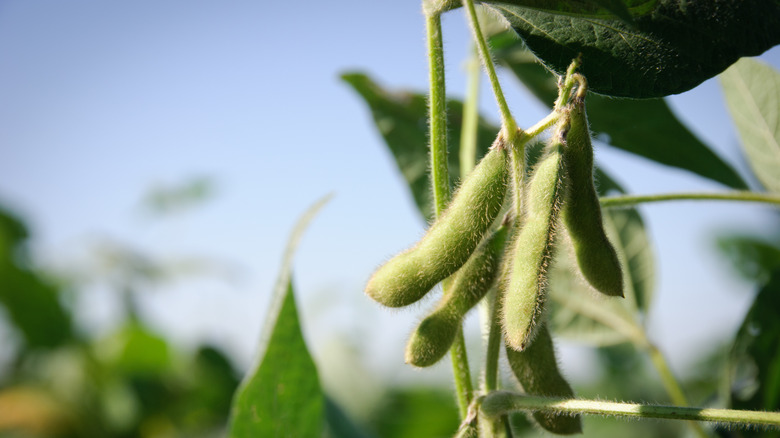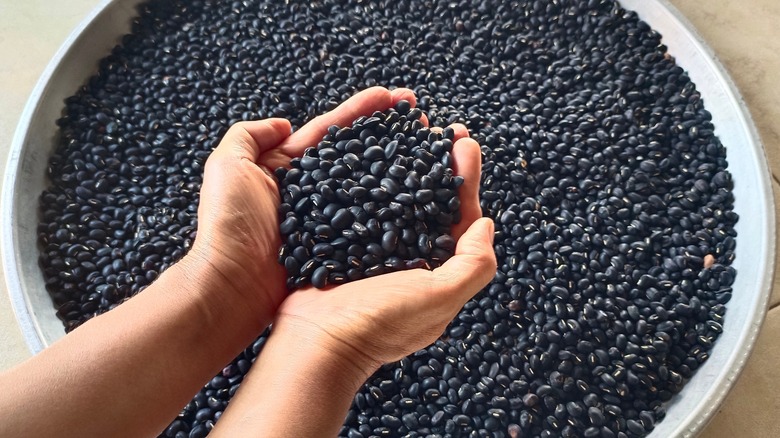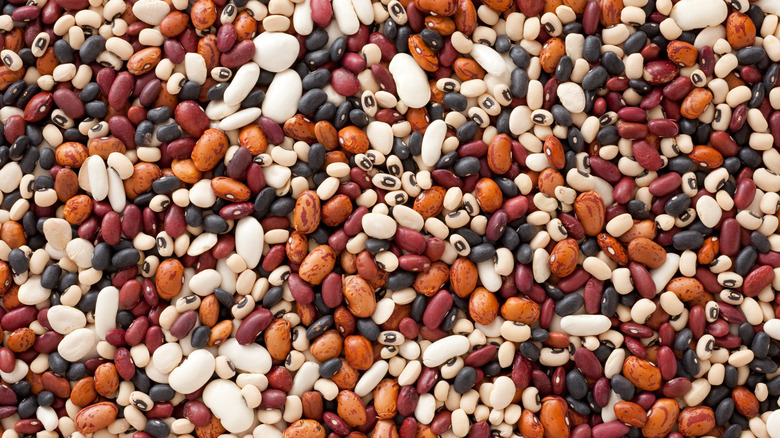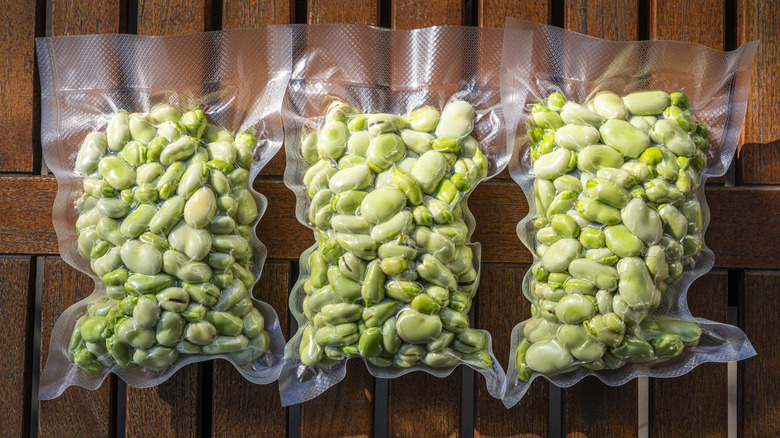What Are Shell Beans And What's The Best Way To Store Them?
Shell beans, shelled beans, shelling beans — no matter what you want to call them, these beans are a terrific addition to your home-cooked menu. They get their name from the fact that they are grown in (and, in the case of fresh shell beans, usually sold in) pods or "shells" that must be removed before eating. Unlike green beans, for instance, whose outer casings are just as delicious (if not more so) than the beans within, shell bean pods don't taste great. The beans inside, though, are quite scrumptious.
In this article, we will be spilling the beans on this delicious, versatile type of legume so that you can not only choose the beans that would work best for your meal, but so you will also know how to shell and prep them for cooking. We will let you know how to store them too, as this is something that can be a little tricky. While dried shell beans can be stored very easily and for a year or more based on their packaging, fresh ones must be kept in the fridge and don't last long. Intrigued? Let's break through those shells and learn more about these beans!
What are shell beans?
If you are like many Americans, you may have done a "science experiment" in school in which you planted some small beans, such as pinto beans. As they grew, you would have seen that the plants formed pods which, after the harvest, were filled with plump little beans. Although you might not have known it at the time, you were growing your own shell beans.
The shell of the bean, in this case, is not the outer skin of the individual bean, but the pod they come in (we're assuming "pod beans" sounded too much like something from "Invasion of the Body Snatchers" to work here). This pod, or shell, is not meant to be eaten because it is thick, fibrous, and develops a rather icky consistency when cooked. Some examples of shell beans include lima beans, edamame, garbanzo beans (also known as chickpeas) and black-eyed peas.
Shell beans can be bought in several forms. You can get them fresh and still inside the pod, in which case you will have to shell them yourself, or you can buy them dried and ready to go, aside from a pre-soak. You can also buy them in a can, which cuts down on both cooking and preparation time.
Fresh vs. dried shell beans
While it is possible to get shelled beans in canned form, the best-tasting ones are either fresh or dried. Both of these varieties have a creamy texture when cooked that makes them a delight to eat, but there are a few notable differences between them. The first is that fresh shell beans usually come in their pods. You will have to remove them from this outer shell before cooking them, which can be a great bonding activity to do with the kids (and it's also quite time-consuming, if you need to keep them distracted while you're prepping dinner).
Another way that fresh and dried shell beans differ is that the latter requires a long pre-soak before cooking; failing to sufficiently soak dried beans is a common mistake people make when cooking beans. Whether you get dried beans in a pod or dried beans in a bag, these do not contain as much moisture as their less mature counterparts and are thus much harder. They will not cook properly if you just toss them in the pan and, speaking from experience, they will give you a stomachache. It is usually recommended to soak your dried beans overnight to ensure that they get fully done and softened up when you cook them.
How to remove shell beans from their pods
Looking for a way to get your shell beans to really open up and come out of their shell? There are a few easy techniques to learn. To start, get your hands on a few pounds of fresh shell beans. One pound of bean pods usually yields around 2 cups of beans, so depending on your family's size, you will have to plan accordingly. You would also be wise to keep in mind that many beans will likely need to be tossed out, as some are shriveled or have moldy pods that make them unusable.
Next comes the fun (and, at times, monotonous) part. Grab one pod of shell beans and split it open. There is often a line that looks like a seam running along the upper side, which can usually be opened with a fingernail. Once you have split the pod, slide your finger down the inside to break the beans loose. If the pod is too tightly sealed for this method, you can also give it a twist to pop the beans out. If you see any small pieces of membrane have made it into the bowl with the beans they were attached to, simply remove them.
Shelling your shell beans often takes quite a while, so it is a great activity to do with family and friends. With a little help, you'll have a pot full of shelled shell beans in no time!
What do shell beans taste like?
There are many varieties of shell beans, but they all have one thing in common: They have a somewhat nutty, creamy flavor when cooked properly. Fresh shell beans are also usually sweeter than their dried counterparts, and are therefore viewed by some shell bean enthusiasts as being the superior choice.
Some shell beans may also have a buttery taste. Lima beans, in fact, are so well-known for this characteristic that they are also called "butter beans." Edamame, on the other hand, is better known for that nuttier flavor that goes great in recipes with rice. It also has a mix of slight sweetness and slight savoriness, giving it a more complex flavor profile.
Other shell beans like black-eyed peas have been described as "earthy," which may sound like an odd descriptor, but actually means that they have a hearty flavor that's slightly reminiscent of plants and soil. Many shell beans like black beans have a meaty flavor, which makes them a good choice for those who want to replace some of the beef in their diet with non-animal forms of protein.
How to cook shell beans
Cooking with shell beans couldn't be simpler: you boil them. That's it. Almost every single dish involving beans, whether it be a soup, a casserole, or just a bowl of beans flavored with meat, vegetables, or aromatics like onions, starts with boiling the beans. If you are cooking with freshly shelled beans, you will most likely just need to boil them for around 10-15 minutes, until the beans are crisp-tender.
If you are using dried shell beans, though, you will need to cook them for quite a while. Depending on the size and type of the beans, the cooking time can be anywhere from 45 minutes to two hours or more. If you want things to go faster, you can try cooking them in a pressure cooker, which will get the job done in 20-30 minutes on average. You should keep in mind, though, that this is after you have soaked them overnight. No matter how you cook them, though, you should always be sure that you do it thoroughly, as not cooking them well enough can lead to digestive issues like gas or nutritional deficiency.
Where to buy shell beans
Shell beans are, luckily, fairly easy to find at your local grocery store. You can find the dried beans in the same section where you would buy other products usually kept in a pantry, as well as online from places like Amazon, Target, or Whole Foods Market. Always be sure to check the date on the beans if you can, though, because these beans can last for a while in storage, so they may be old on the shelf already.
When it comes to fresh shell beans, these are seasonal, so you may have a bit tougher time tracking them down at times. When they are in season, you will find them in the produce department of the grocery store or at your local farmer's market. Look for shell bean pods that look plump with visible lumps where the beans are. You can also buy shell beans that are still in the pod, but drier, but just remember that these will take longer to cook.
How to grow shell beans
Another great thing about shell beans is that, not only are they convenient to buy at the store, but they are also easy to grow. Even the greenest of gardeners can grow them without much hassle and have plenty of beans to harvest and eat with their families at the end of the growing season, which typically spans around 60-70 days from start to finish.
To get started, find a spot in your yard that gets full sun for six or more hours a day. Most soil types will work, but be sure to water frequently as beans like moist soil. When there is no more chance of frost (usually around May in most states), plant beans one inch deep. Check the type of bean you are planting to know how far to space them apart: If you are planting bush beans, you can plant them fairly close, with two to four inches between them, but if you are planting pole beans, you will need to put them four to six inches apart or more.
After that, your work is mostly done. Just keep an eye out for weeds and pests, and stake the plant if necessary. Around two months after the initial planting, your beans will be ready to harvest (you'll be able to tell because they are plump and tender to the touch).
Nutritional information about shell beans
Seeing as there are hundreds of different varieties of shell beans in the world, we won't be going over the nutritional details for each one. We can tell you, however, that all shell beans have some unbeatable nutritional benefits that make them a great addition to most diets. They have, for example, very high amounts of protein, which makes them a satisfying replacement for meat if one wants to go vegetarian for a night (or a lifetime). They also have a lot of vitamins and minerals such as thiamin, fiber, iron, folate, potassium, zinc, and magnesium. Several shell bean varieties like black beans are known to have both anti-oxidant and anti-inflammatory properties as well.
It should be pointed out, though, that these benefits can be canceled out by the side effects of improper cooking. Some beans contain an enzyme that inhibits digestion in humans, for instance, which can cause a nutritional deficiency. This only occurs when the beans are eaten raw, however, as cooking gets rid of this enzyme. Cooking also breaks down shell bean sugars called cyanogens4, which have a small amount of cyanide attached to them, and renders them harmless. To make a long story short: Shell beans are really good for you, but only when cooked!
Varieties of shell beans
When we say that there are many choices when it comes to picking shell beans, we're not kidding. There are more than 500 shell bean varieties out there to try! We won't write out the full list for you, but we will highlight some of the standouts, like red kidney beans, which are perhaps best known for being a great addition to homemade chili recipes. There are also cannellini, which go well in soups. Black-eyed peas are a staple for New Year's celebrations and are usually served with bacon and collard greens, and pinto beans are recognizable for their speckled appearance and ability to be eaten as a meal on their own.
Cranberry beans are also speckled, but unlike their name implies, they do not taste like cranberries (they are just red like them). Black turtle beans, which also don't taste like their name implies, have an interesting flavor that combines richness with a bit of spice, and Marfax beans are a great choice for making baked beans because they are sweet. Then you have lima beans, fava beans, garbanzo beans ... the list goes on and on.
How to store shell beans
Fresh shell beans are wonderful, but their deliciousness is unfortunately short-lived. If you buy shell beans in their pods, you will want to store them in a paper or plastic bag in the refrigerator for three days or less. After this point, they will either get dry or moldy, the latter of which can happen anyway if you don't leave the bag open to prevent humidity from building up inside. You can also use this method to store the beans after they have been shelled, but you should still stick to the three-days-or-less rule if you want them to be fresh.
Dried shell beans, on the other hand, are much less finicky. Dried beans in regular, unopened, food-grade bags like polyethylene can last for a year in the pantry. If they are in vacuum-sealed containers like Mylar, though, they can last a whopping 10 years or more. In fact, a study conducted by Brigham Young University (BYU) found that pinto bean samples that had been in storage for 30 years were still tasty enough to be eaten in an emergency by 80 percent of taste testers.
You can also freeze shell beans by laying them out (sans shell) on a baking sheet and freezing them until they are solid. You can then place the frozen beans in a Ziploc-style bag and keep them in the freezer for up to six months.
